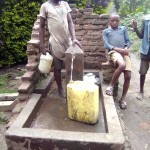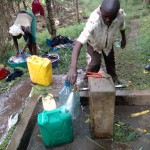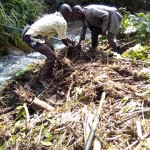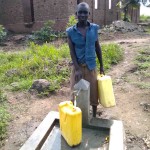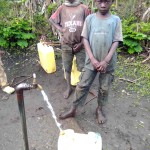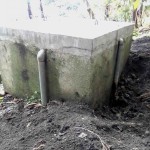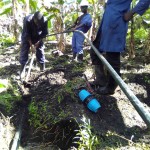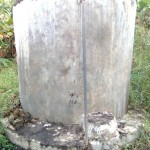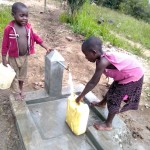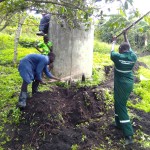COMMUNITY WATER PROJECTS
The basic needs of the people are enormous and are increased by calamities such as drought and epidemics. At present, the single most important task facing KARUDEC is making clean water accessible in the whole district. No homes have indoor plumbing.
Imagine the time and effort consumed in obtaining water, frequently contaminated, and in quantities far below that considered minimal by the World Health Standard of 35 liters per person per day. The average in Kasese District is 10 liters a day. The amount is equivalent to flushing a western toilet 1.5 times. The walking distance to obtain clean water is often several miles. And, the amount obtained is only equal to what an adult or child can carry (one gallon weighs approximately 8 lbs.)
Therefore KARUDEC and her partners have taken it upon themselves with God at the Centre to ensure communities in Kasese access clean and safe water and these communities include Schools, places of worship, Health facilities, business centers and homes.KARUDEC encourages community sharing of the available resources, a water point provided by KARUDEC is not owned by an individual person or a home but by the entire community.
THE COST OF CONTAMINATED WATER
It is no wonder that many families rely on contaminated streams near their homes. As a result, water-related diseases such as diarrhea, infestation with worms and other parasites, cholera and typhoid fever are common. These diseases flourish even more as a result of inadequate sanitary facilities. Less than a third of the households have latrines.
WITHIN REACH
There is adequate water in mountain springs and streams and aquifers in the valleys. Funds are urgently needed to bring the water to the people. KARUDEC’s objective is to pipe water from these sources to a single, sanitary outlet within 1/2 kilometer of the households it serves.
BENEFITS OF COMMUNITY WATER PROJECTS
- Reduces the maximum distance to obtain water by one half
- Increases the average liters per person per day to 15 to 20 liters
- Reduces the incidence of water related diseases by two thirds
- Enables women, the primary water gatherers, to have more time for childcare and chores and to spend less time caring for family members sick with water related diseases
CURRENT WATER PROJECTS SINCE 2017-2019
- Kithoghorwe gravity flow scheme
- Kajwenge-Nyakatonzi gravity flow scheme
- Muyina-Kabwe Gravity flow scheme
FUTURE PROSPECTS
We still have the obligation to reach out to communities with out clean and safe water.so we will continue working with our partners and friends to ensure this is done according to the resources.
HOSPITAL WATER
Kagando Hospital’s demand for water is ever increasing due to ever increased number of patients and attendants, new buildings being set up, guests and staff of KARUDEC this therefore puts the current hospital water on pressure and therefore affecting the flow.
This therefore compelling management and board to start mobilizing resources to boost our hospital water; some water sources have been cited as potential sources of water to boost the hospital.
COMMUNITY MAJOR CHALLENGE
- Kasese district as one of the major districts in which we serve is one of the districts located in the Rwenzori region. This region faces severe climatic change problems especially floods and landslide. Most people in the communities in the Rwenzori region are still using dirty/contaminated water for domestic purposes especially people leaving in hilly areas prone to landslides and river over flooding calamities. This is the reason why we have high prevalence levels of water borne diseases in the region. According to the current hospital visit statistics, there is constantly increasing number of water borne disease cases affecting most people coming to seek medical care at Kagando Hospital from the surrounding communities. The region receives heavy and disastrous rains like the previous rainy season (March – May, 2024) which damaged our main water supply source on River Rwembyo which blocked supply of water to the hospital and the already benefiting community for about 3 days. During this disaster, many people lost lives, many houses were buried in river valleys and may people have been left homeless and in a very poor situation without house shelter, clothing and food. However, with support from our partners in the UK (Friends of Kagando, a charity organization registered in the United Kingdom), we have supplied relief commodities to the mostly affected homes through Rwenzori Women for Health, a charity and community support organisation based at Kagando Hospital( https://friendsofkagando.co.uk/community-work/rwenzori-women-for-health-rwfh/)
- There is also increasing demand for clean water in Kagando hospital and the surrounding communities we serve. The water supplied by the already established water projects is now insufficient to meet the required community water needs for the growing population in the targeted population for each particular project. There is therefore partial supply of community clean water in the areas we serve. This has made the water supply inconsistent with most days of no water supplied to the community.
- More so, there are other many areas which we have not managed to provide with access to clean water due to limited funds.
Latest Articles
 KAGANDO RURAL DEVELOPMENT CENTER (KARUDEC) CELEBRATES THE INTERNATIONAL PREMATURE DAY ON SAT 13TH DEC, 2025
KAGANDO RURAL DEVELOPMENT CENTER (KARUDEC) CELEBRATES THE INTERNATIONAL PREMATURE DAY ON SAT 13TH DEC, 2025 KARUDEC DONOR GRATITUDE MESSAGE
KARUDEC DONOR GRATITUDE MESSAGE EDEN GUEST HOUSE – KAGANDO, KASESE, WESTERN UGANDA
EDEN GUEST HOUSE – KAGANDO, KASESE, WESTERN UGANDA International Nurses’ day Celebrations June, 2025
International Nurses’ day Celebrations June, 2025- (no title) Post 3634
 Uganda Christian University – Kagando University College
Uganda Christian University – Kagando University College THE RT. REV. BISHOP NASON BALUKU VISITED KARUDEC ON THURSDAY, 30th MAY, 2024
THE RT. REV. BISHOP NASON BALUKU VISITED KARUDEC ON THURSDAY, 30th MAY, 2024

